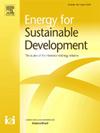A novel concept for optimal operation of multi-swap stations serving electric metrobuses
IF 4.4
2区 工程技术
Q2 ENERGY & FUELS
引用次数: 0
Abstract
Due to the carbon emissions produced by the conventional transportation sector's use of fossil fuels, transportation vehicles are considered one of the leading contributors to global climate change. Additionally, in metropolises like Istanbul/Türkiye, traffic congestion is one of the most significant issues. Taking these factors into account, there is a need to promote the use of public transportation vehicles and electrification of the system. This study focuses on the optimal energy management of multi-swap stations (MSSs) with photovoltaic (PV) systems serving an electric metrobus (EM) line. The presented framework is modeled using a mixed-integer linear programming (MILP) approach. In this system, when the batteries of the EMs on the route are running low, they can come to the stations where the swap operation can be performed, allowing them to exchange their batteries within the passenger boarding and disembarking times. Besides, the power transferring between batteries at swap stations is considered, which helps ensure flexible operation. The PV systems can be utilized for battery charging, and surplus energy can be sold to the power grid. Various test studies are conducted using data from the Istanbul Z34 metrobus route in this research. According to the results obtained from the study, the proposed structure demonstrates the effective operation of swap stations serving EMs. Doubling the PV capacity increased the profit to 6103 Turkish Liras (TL). In October, the highest energy selling revenue of 4791 TL was recorded due to elevated electricity prices. Inter-battery power transfer provided cost savings, with up to 50 TL saved in January, while prioritizing PV energy sales to the grid further reduced operating expenses.
电动地铁多换乘站优化运行的新概念
由于传统运输部门使用化石燃料产生的碳排放,交通工具被认为是全球气候变化的主要贡献者之一。此外,在伊斯坦布尔/伊斯坦布尔等大都市,交通拥堵是最重要的问题之一。考虑到这些因素,有必要促进公共交通工具的使用和系统的电气化。本研究的重点是为电动地铁(EM)线路提供光伏(PV)系统的多交换站(mss)的最佳能源管理。该框架采用混合整数线性规划(MILP)方法建模。在该系统中,当线路上的电动汽车电池电量不足时,它们可以来到可以进行换电操作的车站,在乘客上下车时间内进行换电。同时考虑了换电站电池间的电力传输,保证了换电站运行的灵活性。光伏系统可以用来给电池充电,多余的能量可以卖给电网。在本研究中,使用伊斯坦布尔Z34地铁路线的数据进行了各种测试研究。研究结果表明,所提出的交换站结构能够有效地为EMs服务。光伏发电容量翻了一番,利润增加到6103土耳其里拉(TL)。10月份,由于电价上涨,能源销售收入为4791 TL,创下历史最高纪录。电池间的电力传输节省了成本,1月份节省了多达50 TL,而优先向电网销售光伏能源进一步降低了运营费用。
本文章由计算机程序翻译,如有差异,请以英文原文为准。
求助全文
约1分钟内获得全文
求助全文
来源期刊

Energy for Sustainable Development
ENERGY & FUELS-ENERGY & FUELS
CiteScore
8.10
自引率
9.10%
发文量
187
审稿时长
6-12 weeks
期刊介绍:
Published on behalf of the International Energy Initiative, Energy for Sustainable Development is the journal for decision makers, managers, consultants, policy makers, planners and researchers in both government and non-government organizations. It publishes original research and reviews about energy in developing countries, sustainable development, energy resources, technologies, policies and interactions.
 求助内容:
求助内容: 应助结果提醒方式:
应助结果提醒方式:


